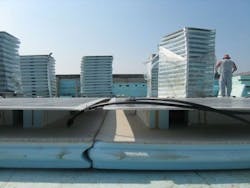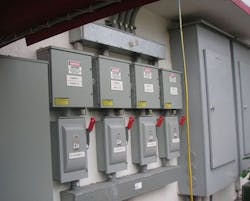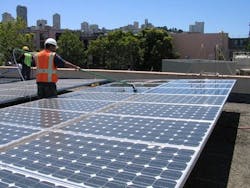Rent-a-Roof
Rent-a-Roof
|
In the late 1980s, the FJ Christiansen Roofing Co. of Milwaukee, WI, introduced an innovative leasing concept in which they would install an appropriate roof system for the building in question, and lease the roof back to the building owner. Rather than using cash from the owner’s capital account, the roof would be expensed along with all other operating expenses on an annual basis. There were many advantages, at least in concept. Christiansen Roofing would determine the best roof for the specific building, design it, install it, and maintain it. They would control new penetrations if needed for rooftop equipment, service the roof if hail damaged, and determine when and if the roof needed to be replaced. Building owners quickly discovered that the annual cash layout required might actually be less than the expenses incurred when an owner has to constantly make emergency repairs and/or has no reserves dedicated to roof replacement. |
The Duro-Last Roofing System:
Precision-Fabricated To Fit Your Building.
For more information, click here.
Fast Forward to 2009
The economic conditions today for building owners may be more critical than they were in 1989, but so are the opportunities.
In June 2009, Advanced Green Technologies of Ft. Lauderdale, FL, announced a program that combines the financial considerations of the earlier concepts with the energy considerations we now face.
Most building owners and readers of this column are aware that photoelectric and other solar systems could be desirable, if they perform as advertised; however, putting together electrical technologies, energy rebates, durability, maintainability issues, and meeting energy codes are daunting.
As with the Christiansen concept, AGT has created a strategic financial alliance (in this case with CTC Resources). The building owner/client is offered financing with $0 down payment, 0 percent interest, and no payments within the first 3 months of the solar system installation. If the PV panels perform as expected, every month thereafter has a payback in terms of reduced electrical consumption, along with refunds for excess power returned to the grid. Solar-generated power also reduces the carbon dioxide released into the atmosphere when compared to coal, gas, or oil, and these CO2 credits may have cash value as well.
According to Michael Kornahrens, president of Advanced Green Technologies, “We are now able to offer a single-point-of-contact to acquire technology, services, and financing on a timely and economical basis.” Navigating the rebate market also requires professional help. It’s apparent that many of the financial incentives being offered will be temporary in nature, indicating a degree of urgency in designing and installing systems that qualify for the offered rebates.
In the opinion of most roofing professionals, it makes little sense to install rooftop solar on roof surfaces that are near the end of their life. Between the construction traffic that can be expected during installation of the panels and the difficulty of maintaining the roof once covered with panels, the roof (in most cases) should first be upgraded with a more heat- and puncture-resistant membrane. (See Figs. 1-4.) And, what better time to upgrade the thermal insulation and rectify drainage problems?
(COURTESY OF ADVANCED GREEN TECHNOLOGIES)
(COURTESY OF PHIL DREGGER)
(COURTESY OF T-CLEAR CORP.)
(COURTESY OF ADVANCED GREEN TECHNOLOGIES)
For maximum performance, it may be necessary to wash PV panels periodically to remove airborne grime. (See Fig. 5.) This probably will be necessary on all cool roofs as well.
(COURTESY OF VENK MANI)
Another consideration with PV systems will be the strength of the supporting structure. In colder climates, it’s sometimes necessary to remove snowdrifts to prevent roof collapse. Both snow blowers and manual shoveling, along with the associated foot traffic, may damage PV panels. PV panels should be kept away from the roof edges, flashings, and the perimeter. There also is concern that heavy hail impact (2-inch diameter and greater) might threaten the viability of panels. Fire, hail, and wind ratings, such as those provided by UL Inc. and FM Global, need to be included during the design phase of PV systems.
All of these can best be addressed by carefully examining the current roof system before the PV installation begins. If the current roof system does not drain well, there are a number of options: add additional roof drains, utilize a tapered roof insulation system, or even add a tapered lightweight insulating fill as part of the re-roof or re-cover process.
With creative financing, a new, upgraded roof system utilizing solar panels and increased thermal will not only be affordable, but highly desirable as well.
Dick previously received the William C. Cullen Award and the Walter C. Voss awards from ASTM Intl., as well as honorary membership in Committee D08 on Roofing and Waterproofing.
Fricklas participates in roofing technology programs for the University of Wisconsin Extension Division, and assists RCI Inc. (formerly The Roof Consultants Institute) in the development of curricula for its registration programs. He is a columnist for Interface Magazine, as well as Buildings’ Roofing Newsletter. In 2006, he, along with coauthor Bill Griffin, completed the fourth edition of the Manual of Low Slope Roofing.
Dick is an honorary member of RCI Inc. and has received many other honors, including the JA Piper Award from the National Roofing Contractors Association (NRCA), the James Q. McCawley Award from the Midwest Roofing Contractors Association (MRCA), and Lifetime Achievement Awards from the Educational Foundation of the Institute of Roofing and Waterproofing Consultants, and from the Colorado Roofing Association.
He’s a graduate of Hofstra University and received an MS in physical chemistry from Rutgers University.
Before retiring, Fricklas was technical director of the Roofing Industry Educational Institute (RIEI). He had previously held positions as director of the Better Understanding of Roofing Systems Institute (BURSI) and as a research chemist for Johns Manville and the Riegel Paper Corp. He, with his wife, Anita, resides in Centennial, CO.
Buildings > @ the Moment | Weekly newsletter of topical issues for facilities professionals.
Buildings >Security | In-depth security information for facilities professionals.
Buildings > Roofing News | In-depth roofing information for facilities professionals.
Buildings > Bottom Line Energy Issues | In-depth energy information for facilities professionals.
Buildings > Greener Facilities | Understand the explosive growth and acceptance of green buildings
























